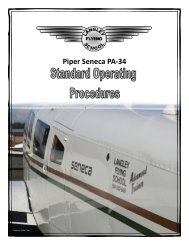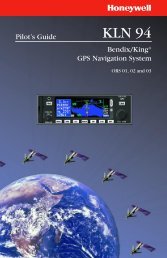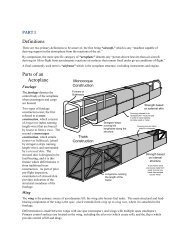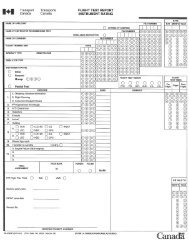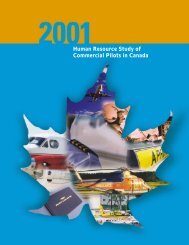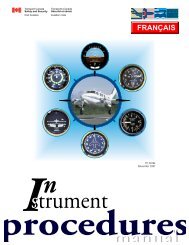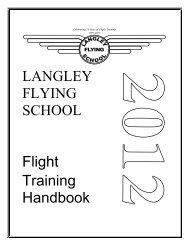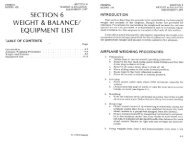<strong>Private</strong> and Recreational <strong>Pilot</strong> <strong>Groundschool</strong> <strong>Manual</strong> Page 28<strong>Langley</strong> <strong>Flying</strong> <strong>School</strong>, Inc.From the Ground Up).A more fundamental variation in undercarriage is conventional and tricycle gear—the former having a tail wheel,and the latter having a nose wheel.While conventional gear provides greater manoeuvrability, there are the risks of the aircraft performing a “noseover,”or “ground looping” (tail moving sideways out of control). Conventional gear also presents decreasedvisibility during aircraft taxi and takeoff.In contrast, tricycle gear provide increased control in cross-wind takeoffs and landings; but the design also hasground hazards such as wheelbarrowing on the nose, and “porpoising.” Tricycle gear provides increased drag(slowing the aircraft down), is more expensive to maintain, and is not as strong as conventional gear.Load and Load Factors<strong>Pilot</strong>s must be extremely conscious of structural load and load factors. During manoeuvring in the air, the loadingon the aircraft—and thus the loading stress placed upon the structural components of the aircraft—are continually intransition. You must be aware how the loading changes, and aware that structural failure will result if the load limitsare exceeded.A load factor is simply a weight ratio of the “dead load” (aircraft on the ramp) to the “live load” (in motion). On theramp, without motion, the aircraft weighs 1 times its gravity weight—say 2000 lbs. This changes, however,whenever the aircraft is accelerating/decelerating, climbing/descending, or during turns. In fact the only time anaircraft weighs 1 times its gravity weight (referred to as 1 “g”) is when it is in straight and level flight at a constantairspeed.During a climb, the aircraft has increased weight as it moves away from the earth. During turns or pitch changes,the aircraft is subject to centrifugal force. Consider that in a level 30-banked turn (wings 30 off the horizon), theaircraft weighs 1.15 times it gravity weight (1.15g). The same aircraft, including its occupants, weighs 2.0g in alevel 60° banked turn, and 5g in level 80° banked turn—that is to say, the 2000 lb. aircraft on the ground nowweighs 4000 lbs. and 10,000 lbs., respectively. For this reason, with the exception of fighter and aerobatic aircraft,pilots attempt to manoeuvre aircraft very gently, paying close attention to load factors.Load factor variation is closely related to airspeed. A rapid pitch-up movement that produces maximum lift in anaircraft travelling 2-times its stall speed will produce a force on the aircraft equal to 4 g; the same manoeuvre in anaircraft travelling 4 times its stall speed will exert a force of 16g!An aircraft’s yield load factor is when the structure will begin to bend and become distorted; its ultimate load factoris when the wings break off.Fortunately, Transport Canada enforces Official Aircraft Specification for normal category aircraft (as opposed toexperimental category aircraft) that requires the aircraft meet load standards prior to its being certified.Normal and Utility CategoriesMost general aviation aircraft can be operated in what are referred to as the normal and utility categories; these arecommonly referred to as aircraft loading categories.The normal category enables a pilot to operate his or her aircraft at its maximum permissible gross weight providedthat certain heavy load manoeuvres are not flown—spins, steep turns, etc. Following these restrictions, he isensured the aircraft will withstand 3.8g positive and 1.52 negative.The pilot can also operate the same aircraft in the utility category, whereby he or she is less restricted in manoeuvresthat can be flown (e.g., spins and stalls are approved) provided the aircraft is kept in much narrower weight andloading restrictions; in this utility category, the pilot is assured the aircraft can withstand 4.4g positive and 1.76gnegative. The utility category would therefore be used extensively in training or practice flights.Aerobatic aircraft can have even greater strength—aerobatic certification of an aircraft assures as high as 6g positiveand 5g negative.Manoeuvring Speed and Gust Loads© 2012 David L. Parry
<strong>Private</strong> and Recreational <strong>Pilot</strong> <strong>Groundschool</strong> <strong>Manual</strong> Page 29<strong>Langley</strong> <strong>Flying</strong> <strong>School</strong>, Inc.All pilots must be aware of “gust loads” typically associated with air turbulence. For pilots, one of the mostimportant speeds is referred to as the manoeuvring speed (V a ).At or below an aircraft’s manoeuvring speed, the aircraft’s controls can be fully deflected without exceeding loadlimits.As a rule, V a equals 1.9 times the stall speed of the aircraft at gross weight. It is specifically published in individualaircraft’s <strong>Pilot</strong> Operating Handbook.Since extreme turbulence can entail momentary acceleration, safe practice is to fly 10 knots (KTS) less than V a inturbulence.Logbooks and InspectionsEach flight in an aircraft must be recorded in three logbooks—the <strong>Pilot</strong>’s Log (see page 19), the aircraft’s JourneyLog, and the aircraft’s Technical Logs.Aircraft Technical Logs record maintenance, modifications, and installations, and are composed of three sub-logs:an Airframe Log (modifications and installations), an Engine Log, and a Propeller Log. Technical Logs are nevertransported on aircraft. The Engine Log records and documents all maintenance performed on the aircraft.Journey Logs record aircraft destinations, flight crew, weight data, air time (total period of time from aeroplaneleaving the surface to time of aeroplane landing), flight time (total period from time aeroplane moves under its ownpower to time the aircraft stops at the termination of flight), total airframe time, records of inspection, and defects orsnags.All maintenance recorded in the technical logs must be transcribed in the Journey Log. When intending to land andshutdown at an airport other than the airport of departure, the Journey Log must always be transported in aircraft andcompleted and signed by the<strong>Pilot</strong>-in-command following aflight. 11Certificates ofAirworthinessWith the exception of hanggliders and ultra-lights,aircraft must have authority tofly (flight authority), and thisauthority is provided byTransport Canada is the formof a Certificate ofAirworthiness.A Certificate of Airworthinessimplies that a particularaircraft conforms to a typedesign that has been certifiedby the Transport Canada assafe for flight. 12 They must becarried on board during flight.Flight authority is providedby three means: a Standardcertificate of airworthiness, aSpecial certificate of airworthiness, and Flight Permits.5. Authority and basis for issuanceThis Certificate of Airworthiness is issued pursuant to the Aeronautics Act andcertifies that, as of the date of issuance, the aircraft to which it was issued hasbeen inspected and found to conform to the type approval thereof, to be in acondition for safe operation, and has been shown to meet the requirements ofthe comprehensive and detailed airworthiness code . . .6. Terms and ConditionsUnless suspended or cancelled in accordance with the Aeronautics Act, thiscertificate shall remain in force so long as the aircraft identified above ismaintained and certified in accordance with the Airworthiness <strong>Manual</strong>.11CARs 605.94 and 605.95.12CAR 507.02.© 2012 David L. Parry



